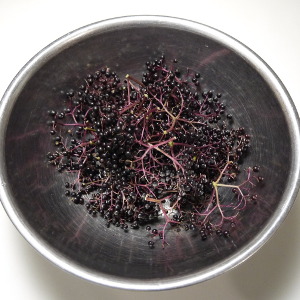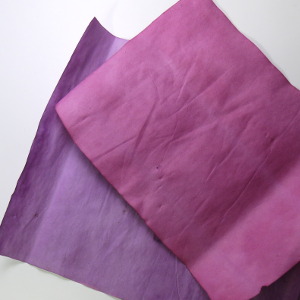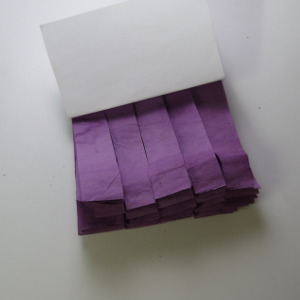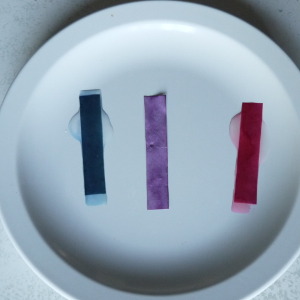home |
electronics |
toolbox |
science club |
tuxtalk |
photos |
e-cards |
online-shop

Homemade acid/base indicators, PH indicators
A lot of plants with colors other than green are usable as a PH indicators.
Some of the most commonly known ones are:
- Litmus, a dye extracted from lichens.
- Red cabbage extract
The litmus paper is used in labs around the world to test whether a solution is acidic or basic.
The advantage of litmus is that it can be stored over many years and remains usable.
| Litmus PH indicator |
|---|
| below ph 4.5 | above ph 8.5 |
Red cabbage
Red cabbage is cheap, very color intensive and can actually indicate the PH of a solution in fine grained
steps. The problem is it works best with fresh cabbage and the extract is only usable for a couple of weeks.
It is however still a very useful "home made" PH indicator and it's a nice experiment for
a science class in school. To make red cabbage extract you cut a few leaves of red cabbage into
small slices or you can put them into a mixer.
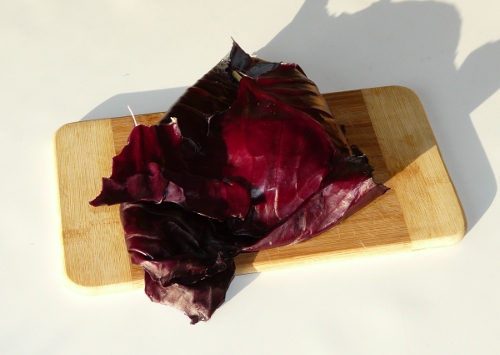
red cabbage leaves
Add a 50-70% alcohol water solution and let
it sit for about 15 minutes. I recommend to use real ethanol and not isopropyl alcohol if you
do this experiment with children where it is difficult to avoid that some get in contact with the alcohol. Both ethanol and isopropyl-alcohol are toxic but ethanol is
less toxic to humans. Isopropyl causes kidney damages even if it is just used externally over a longer
period of time. Short exposure of a hand or the inhalation of the vapor for a few minutes is supposedly not dangerous but ethanol is for sure less dangerous.
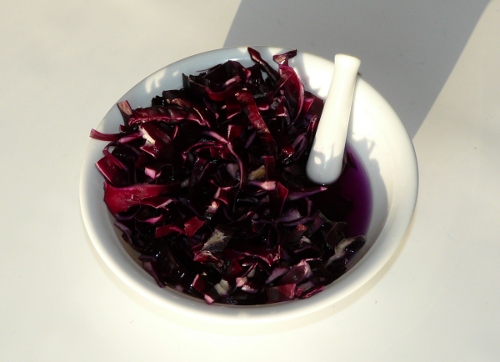
red cabbage extraction process
Separate the cabbage from the now dark colored alcohol solution by pressing it through a cheese cloth
and fill the red cabbage indicator solution into a small bottle for storage.
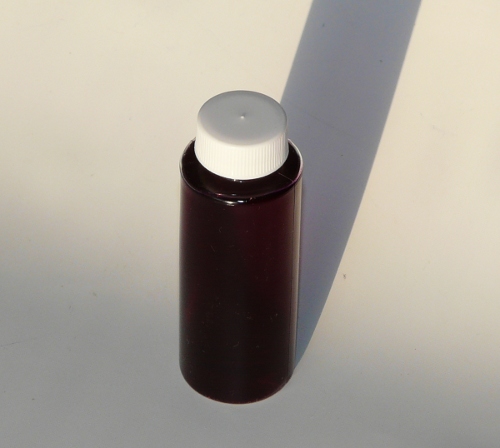
red cabbage extract PH indicator
To test the PH of any liquid just add a few drops of the red cabbage extract and then compare the color with the following
table.
| Red cabbage extract PH indicator |
|---|
| ph 0-1 |
ph 2 |
ph 4 |
ph 5-8 |
ph 9 |
ph 10 |
ph 11-14 |
More stable PH indicators
Red cabbage is a very good PH indicator but is looses its ability to indicated the PH over a couple of weeks or month depending on how you store the solution.
More stable PH indicators that can easily made at home are:
- Turmeric (the yellow part of Curry Powder) => very stable, usable for many years
- Radish peels => somewhat stable, usable for a few month
- Elderberry => very stable, usable for many years, makes paper that is equivalent to real litmus paper
Radish is similar to red cabbage in the sense that it can indicate
the PH in many fine grained steps where as Turmeric and Elderberry have just two colors.
Turmeric as PH indicators
Turmeric powder can be found in the spices section of you supermarket.
It is as well the yellow part of Curry Powder.
The best way to store turmeric over longer periods is to store it as powder.
To use it just mix a bit of powder with water.
| Turmeric PH indicator |
|---|
| below ph 7.4 | above ph 8.6 |
Radish peels as PH indicator
Radish extract is produced in the same way as red cabbage extract. Just peel the
red skin off several radishes and then extract the dye using an alcohol water
solution.
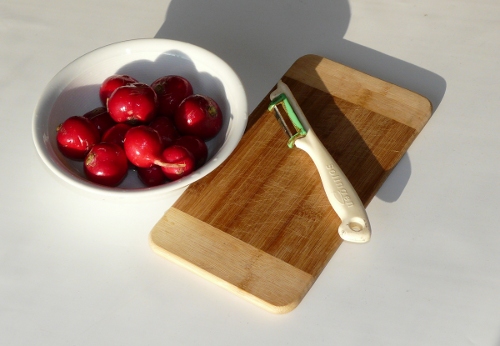
radish
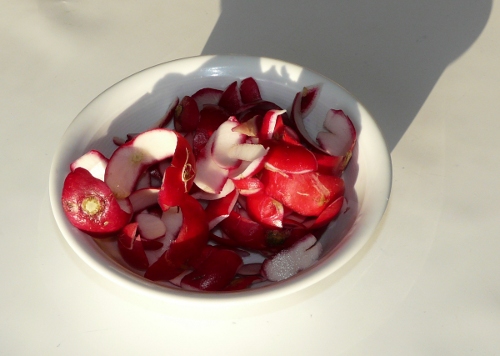
radish skin peeled
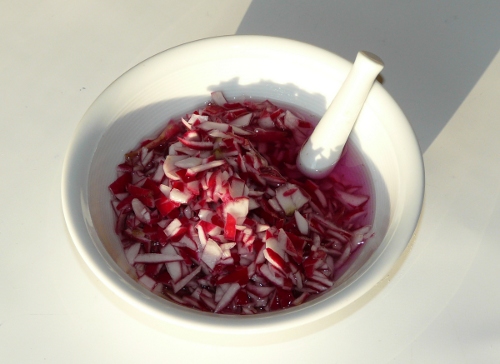
radish peels extraction with alcohol and water
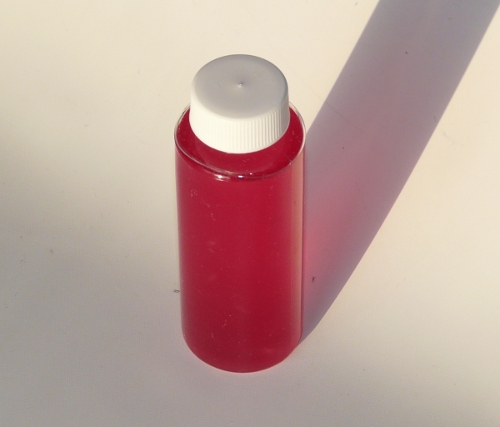
radish extract PH indicator
Radish extract changes its color according to the PH as shown in the
below table.
| Radish extract PH indicator |
|---|
| ph 0-2 |
ph 3 |
ph 4-7 |
ph 8-9 |
ph 10 |
ph 11-14 |
European Elder (sambucus nigra)
The European Eldertree is a shrub that grows best in humid soil and it can
get up to 15 feet (5m) high but it takes many years to get to that height. You can find this bush also in the colder parts of north America (Canada and northern states of the USA). In areas like Canada where we
get a lot of snow it will usually not get to the full hight as the wood of the Eldertree is not very strong and
long branches will easily break off under the weight of the snow. It has white flowers in June and around August time small black looking berries.
The juice from the berries makes an indicator
that works exactly like litmus. Use a hand full of dark ripe elder-berries
and add about the same volume of water. Cook the berries in the water for
about 2 minutes. Filter through a cheese cloth and squeeze it to get as much
juice as possible.
Add a bit of pure alcohol (ethanol or propanol) to the liquid as a
preservative. You can as well soak acid free art paper or a kitchen sponge towel (kitchen paper towel)
with the juice and let it dry to make "litmus paper". Note that most paper towel paper is acidic and
you will therefore get red litmus paper even if you start to make the paper from a neutral elderberry juice solution.
Note that the elder berries
are already slightly acidic (mostly ascorbic acid). You have to add a few drops of a soda and water
solution to get it into the neutral range or you could leave it as it
is and use it as an indicator for the higher ph ranges.
| Elderberry PH indicator (similar to litmus) |
|---|
| below ph 4 | around ph 7 | above ph 8 |
It looks like Elderberry has 3 levels but the neutral is more or less a mixture of red and blue. There are really only 2 clearly distinguishable colors.
Both the Elderberry paper and the liquid are very stable and can be used for many years.
Blueberries
The the outer skin of blueberries contains the same kind of PH-indicator as Elderberries. To extract the blue color you can either boil the berries or freeze them. The easiest way is probably to just buy frozen blueberries. You can make "litmus paper" from blueberry juice and the paper continues to work for many years. The colors are the same as for Elderberry (see above).
References
© 2004-2025 Guido Socher


